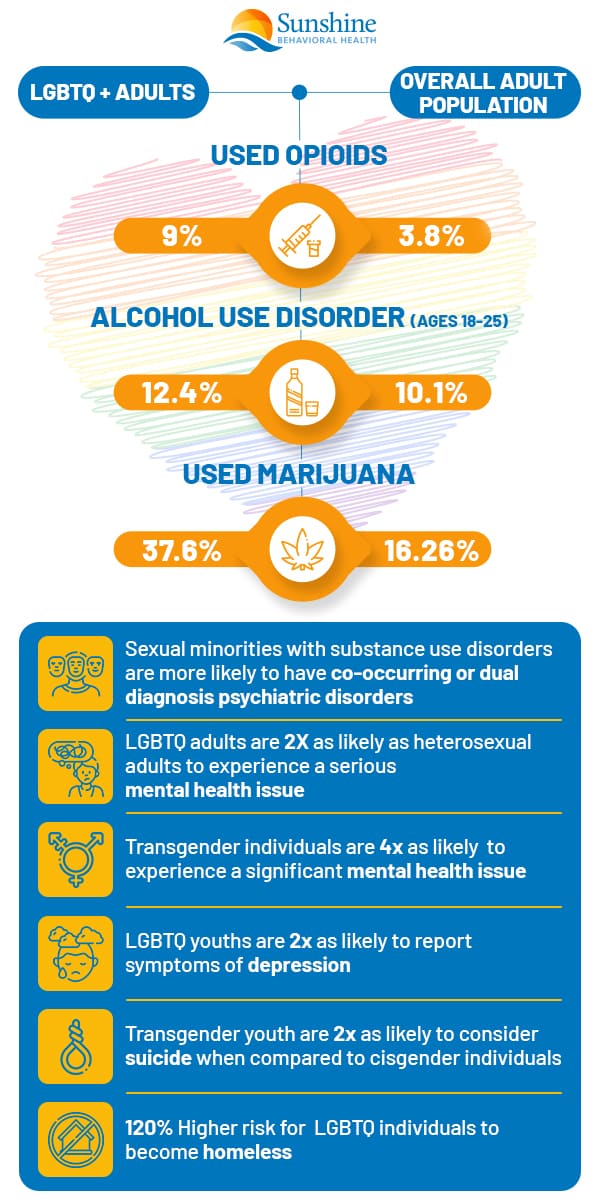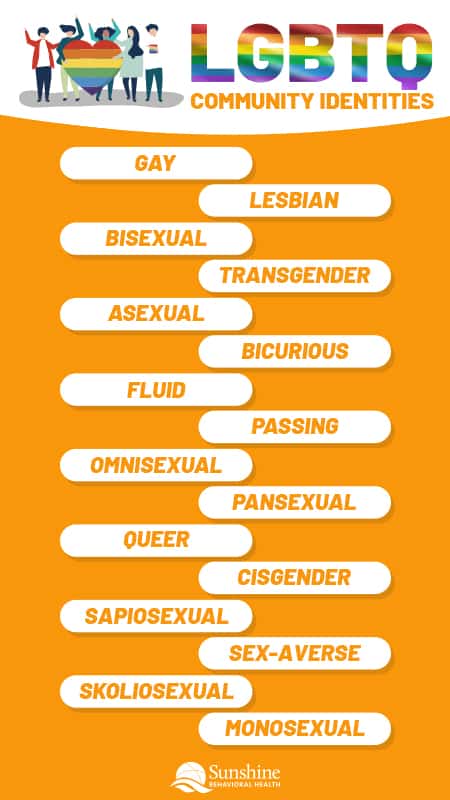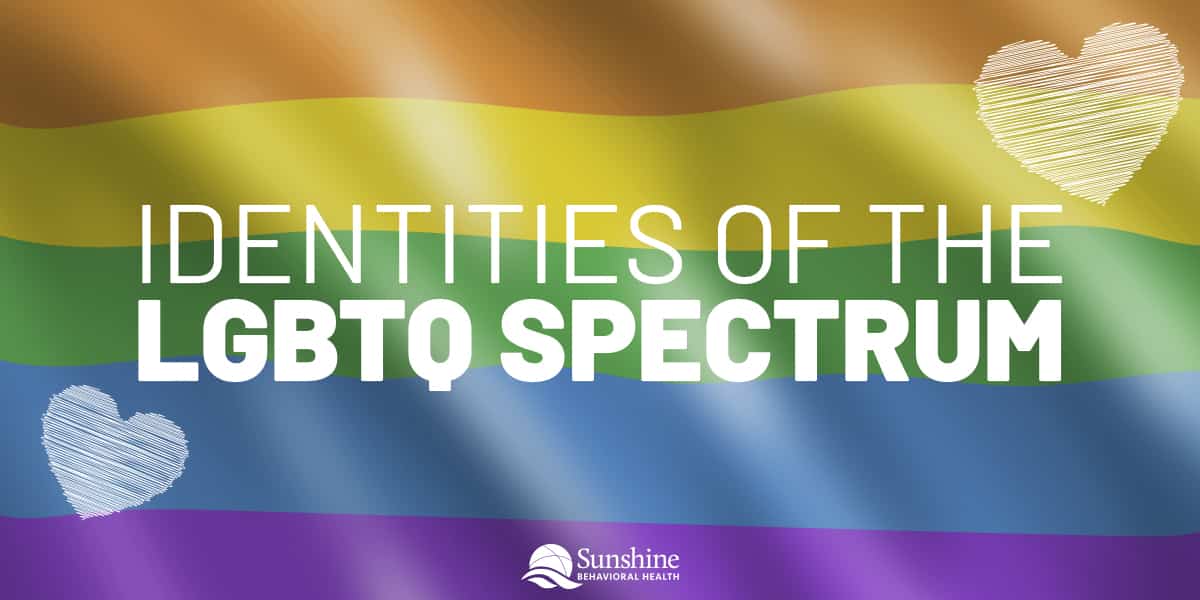The LGBTQ community represents a wide variety of sexual identities and gender expressions that concern orientation. In addition to these various gender and sexual identities, members of this group also come from a wide variety of socioeconomic classes, ethnicities, nationalities, backgrounds, and religions.
This unique intersectionality, combined with the numerous overlapping aspects of an individual’s identity, contributes to a wide variety of thoughts, perspectives, experiences, and understanding.
Even though belonging to the LGBTQ community can certainly be a source of strength, it also leads to a wide variety of challenges. A lot of LGBTQ individuals have issues recognizing how their sexual orientation and gender identity contributes to their lives moving forward.
Because this group has been marginalized in the past, and still experiences stigma to this day, many members of the community do not know where to go for help. Therefore, it is important for everyone to be familiar with the myriad of identities that are covered under the LGBTQ umbrella.
Statistics: The LGBTQ Community and Mental Health
There is a significant amount of recent research that shows that members of the LGBTQ population are at a significantly greater risk of experiencing mental health issues, particularly depression and anxiety, when compared to people who are not members of the LGBTQ community.
A few statistics include:
- According to the Substance Use Disorder and Mental Health Services Administration (SAMHSA), LGBTQ adults are twice as likely as heterosexual adults to experience a serious mental health issue.
- According to Transgender Health, transgender individuals are four times as likely as cisgender individuals (whose birth sex matches their gender identity) to experience a significant mental health issue.
- According to the Centers for Disease Control and Prevention (CDC), LGBTQ youths are twice as likely to report symptoms of depression when compared to their peers who are heterosexual.
- According to a study published in the Journal of Adolescent Health, transgender youth are twice as likely to consider suicide when compared to cisgender individuals, including those who are lesbian, gay, or bisexual.
These statistics show that LGBTQ people are at a greater risk of experiencing mental health issues. Members of this community often face discrimination, denial of civil rights, denial of basic human rights, harassment, and even rejection from their own families. Therefore, it is important to develop a greater understanding of LGBTQ gender identities. One of the ways to do this is to look at the intersection of gender identity and psychology.

How Does Gender Identity Relate to Psychology?
Gender identity and psychology are intrinsically tied to one another. It is impossible to discuss gender identity without discussing psychology. Gender identity describes someone’s own psychological perception of being male, female, both, neither, or somewhere in between.
Even though most people have a gender identity (or the perception of being male or female) that is consistent with their biological or birth sex, this is not always the case. When someone is transgender, they may have the biological or birth sex of a male yet identify as female. The reverse is also true, where someone may be born as female and identify as male. Some people may believe their gender identity is somewhere between completely male and completely female.
Importantly, there may be variations of biological sex. Even though many people in the Western world believe that people are either completely male or completely female, sex is actually much more nuanced than that.
For example, there are some people who are born with bodies that do not appear completely male or female. Instead, they may have features of both. This term is called intersex. As an example, one study showed that as many as two percent of people might be born with intersex features. Therefore, being intersex may be more common than many people realize.
Unfortunately, people who are born with a biological or birth sex that does not match their gender identity are at risk of developing serious mental health issues. It can be psychologically confusing for people who experience gender identity issues because they may feel like they have trouble relating to people.
Because they may not know how to cope with the situation, they may develop mental health issues as a result of unhealthy coping mechanisms. Furthermore, many of these issues may have developed during childhood because their peers may not have known how to interact with them. When this is combined with a lack of education on LGBTQ issues, this can lead to mental health issues.
As a result, it’s a good idea to take a closer look at the risk factors linked to LGBTQ mental health.
Major Risk Factors in LGBTQ Mental Health
There are several important risk factors that may contribute to the development of mental health issues among the LGBTQ community. These include:
Coming Out
Coming out — where LGBTQ individuals reveal their gender identity or sexual orientation with others — has been a major issue. Even though it is a positive change that society is more accepting of the LGBTQ population, this also means that some children are coming out at a younger age. This could adversely impact their relationships and social experiences during these formative years, leading to the development of mental health issues.
The Fear of Rejection
Coming out also creates a fear of rejection. Rejection can be a negative, traumatic experience. For example, one survey that was conducted in 2013 showed that 40 percent of LGBTQ adults experienced rejection from a family member or a close friend as a result of coming out.
When they come out, members of the LGBTQ community need the support of their family members and friends. Losing that support can create a feeling of rejection, leading to mental health issues.
Traumatic Experiences
Both LGBTQ children and adults are also prone to experiencing discrimination in the form of transphobia, biphobia, homophobia, and bullying. That discrimination can be traumatic. Furthermore, a report published by the New York Times showed that LGBTQ populations are the most commonly targeted community by perpetrators of hate crimes in the country. These traumatic experiences can increase the risk of developing mental health issues.
Substance Use Disorder Issues
Members of this community are also prone to experiencing substance use disorder issues. Substance misuse and overuse are common coping mechanisms as a way to try and dull their traumatic experiences. For example, one report showed that LGBTQ individuals are nearly twice as likely as heterosexual adults to develop a substance use disorder. Substance use disorder can also lead to the development of mental health issues, and vice versa.
LGBTQ individuals tend to have more severe substance use disorders when they go into rehab. When they have substance use problems they’re also more likely to have other psychiatric disorders. Those are dual diagnosis, co-occurring, or comorbid disorders. Higher levels of depression or self-harm, for example, may lead to or result from substance use as a form of self-medication. In recovery, it’s important to address all underlying issues along with the addiction.
Homelessness Problems
Members of the LGBTQ community are also at a greater risk of experiencing homelessness, which can also lead to mental health issues. A report published in 2018 showed LGBTQ individuals are at a 120 percent greater risk of experiencing homelessness at some point in their lives. Often, homelessness stems from the rejection of a family member after coming out.
Homelessness tends to affect more Black and multiracial LGBTQ youth. It also can shorten life expectancies and lead to more severe forms of trauma and discrimination.
The Risk of Suicide
Finally, LGBTQ populations are also at a greater risk of attempting suicide. Suicide stems from the direct results of depression, often untreated for an extended amount of time. Because LGBTQ individuals often have a harder time accessing mental health resources, they are also at a greater risk of suicide. For example, 40 percent of adults who are transgender have attempted suicide at some point in their lives.
There is a direct relationship between the LGBTQ community, gender identity, gender expression, overall psychology, and mental health. One of the ways to address these mental health issues is to remove the stigma from being LGBTQ. Educating others on important definitions can be a helpful tool.
Important Definitions in the LGBTQ Community
There are several important definitions that everyone should understand when it comes to the LGBTQ community. While there are many people who understand what it means to be lesbian, gay, bisexual, and transgender, there are other identities people should be familiar with as well. These include:
- Asexual: Asexual refers to gender identity and orientation that does not experience sexual attraction to people of any gender. Many people who are asexual are referred to as “aces.”
- Bicurious: Someone who is considered to be bicurious is actively questioning or exploring bisexuality. This includes people who are curious about romantic attraction to a range of genders and sexes.
- Fluid: This refers to the fact that sexuality, sexual behavior, and sexual attraction can change over time. It may even be dependent on the situation. Someone who describes their sexuality as fluid experiences shifts in their sexual attraction over time.
- Passing: Passing refers to an individual who is transgender who is actively living life as a member of the opposite gender when compared to their birth gender. This can be a source of positive mental health for someone in the transgender community.

- Omnisexual: Omnisexual refers to someone whose sexuality is not limited to a specific gender, sex, or sexual orientation.
- Pansexual: This refers to someone who experiences sexual, romantic, or emotional attraction to any individual, regardless of that person’s sexuality, sex, or gender.
- Queer: This is an umbrella term that is used to cover anyone who is not exclusively heterosexual. Even though this term does include lesbian, gay, and bisexual individuals, this also includes individuals who do not fit neatly into these categories either.
- Questioning: Questioning refers to someone who is curious about a specific aspect of his or her sexuality or gender. This can also be used to describe someone who is currently exploring interactions with people or different orientations.
- Cisgender: This term describes someone whose biological sex matches their gender identity. For example, someone who is born with male genitalia and identifies as male is described as being cisgender.
- Sapiosexual: This is a term that is used to describe individuals are attracted to someone based on intelligence instead of other physical feature.
- Sex-averse: This is a term that is used to describe someone who is avoidant or extremely disinterested in sexual activity.
- Skoliosexual: This is a term that is used to describe people who are actively interested in people who are not cisgender. This could include people who are nonbinary or transgender. Some people do not like the term, however, and prefer ceterosexual instead.
- Monosexual: This refers to someone who is only attracted to a single sex or gender. This refers to people who are exclusively lesbian, gay, or heterosexual without interest in anyone who is outside of that single gender.
- Pronouns: These are words used to refer to someone, used in place of their name or a noun. Common ones are she/her, he/him, and they/them. There are gender-neutral variations as well.
Becoming familiar with these terms can provide valuable lessons about LGBTQ culture.
LGBTQ Mental Health Resources
A few helpful mental health resources regarding issues LGBTQ groups face:
- The National Alliance on Mental Illness (NAMI), provides comprehensive resources that are available for all issues related to mental health, including those specific to the LGBTQ community.
- The SAMHSA National Hotline is for anyone struggling with anxiety, depression, or other mental health issues. It is staffed 24 hours per day, seven days per week.
- The Association of Gay and Lesbian Psychiatrists, which provides many resources for LGBTQ individuals who are experiencing mental health issues.
- The American Psychology Association (APA), which provides educational support and resources on a host of topics related to the LGBTQ community
- National Suicide Prevention Lifeline. If you or a loved one is considering taking their life, call 800-273-8255. There are LGBTQ resources on the site, too.
Helpful Links:
Sources
Medical disclaimer:
Sunshine Behavioral Health strives to help people who are facing substance abuse, addiction, mental health disorders, or a combination of these conditions. It does this by providing compassionate care and evidence-based content that addresses health, treatment, and recovery.
Licensed medical professionals review material we publish on our site. The material is not a substitute for qualified medical diagnoses, treatment, or advice. It should not be used to replace the suggestions of your personal physician or other health care professionals.






